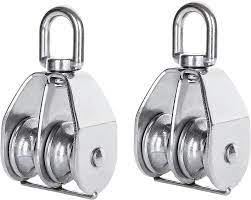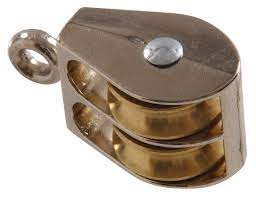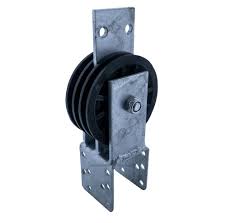Product Description
Plastic Pa66 Pulley with double bearing
Mc nylon, means monomer casting nylon, is a kind of engineering plastics used in comprehensive industries, has been applied almost every industrial field.
The caprolactam monomer is first melted, and added catalyst, then poured it inside moulds at atmosphere pressure so as to shape in different castings, such as: Rod, plate, tube. The molecule weight of mc nylon can reach 70, 000-100, 000/mol, 3 times than pa6/pa66. Its mechanical properties are much higher than other nylon materials, such as: Pa6/pa66. Mc nylon plays a more and more important role in the material list recommended by our country.
Since the end of 1980’s, HangZhou engineering plastics industireis company has devoting herself on developing the technology of mc nylon modification, greatly extended the applications in different industries. Basing on the mc nylon, reinforced with variety of additives during the reaction, such as lubricant, molybdenum disulfide, graphite glass fiber, carbon fiber etc, to improve the properties, higher performance of wear-resistance, corrosion-resistance, self-lubrication, vibration-absorption, noise-absorption. At the same time, as the technics and structure of the moulds is quite simple, so that it can be manufactured in lower cost, becomes the ideal substitutes of bronze, stainless steel, babbitt alloy, ptfe and so on.
Oil nylon (green)
Oil nylon(green)is the new engineering plastics that developed by HangZhou engineering plastics industireis company in the later 1980’s by importing the advanced technology from nylacast co., ltd, uk, was the first authentic lubricating nylon that builds the liquid lubricant system during the processing stage, which makes its coefficient of friction is 50% lower than the general pa6 or pa66, the wear-resistance is 10 times than the general ones. Oil nylon is specially developed for the parts of non-self-lubrication, heavy-loading and low-speed-running, which obviously resulted in a substantial increase in bearing life- 5 times that of general pa6 and 25 times that of phosphor bronze! The lubricant contained within the material will not drain, adsorb or dry out and never needs replenishment. The uniform distribution of the lubricant throughout the product guarantees the constant performance of the parts over the whole service life and improvements in rate of wear, sliding frictional properties, abrasion resistance and stick slip performance, which are just a few of the benefits offered by this material. Oil nylon has been successful in considerable enlarging the application of nylon in many industries and specifically for some un-lubricated running parts.
Other casting nylon:
Oil nylon + carbon (black)
Oil nylon added carbon, has the very compact and crystal structure, which is better than the general casting nylon in the performance of high mechanical strength, wear-resistance, anti-aging, uv resistance and so on. It is suitable for making the bearing and other wear mechanical parts.
Oil mc901(blue)
This improved mc nylon, has striking blue color, which is better than general pa6/pa66 in the performance of toughness, flexibility, fatigue-resistance and so on. It is the perfect material of gear, gear bar, transmission gear and so on.
Mc nylon + mso2(light black)
Mc nylon added mso2 can remain the impact-resistance and fatigue-resistance of casting nylon, as well as it can improve the loading capacity and wear-resistance. It has a wide application in making gear, bearing, planet gear, seal circle and so on.
| Property | Item No. | Unit | MC Nylon (Natural) | Oil Nylon+Carbon (Black) | Oil Nylon (Green) | MC90 (Blue) | MCNylon+MSO2(Light Black) | |
| Mechanical Properties | 1 | Density | g/cm3 | 1.15 | 1.15 | 1.135 | 1.15 | 1.16 |
| 2 | Water absorption (23ºCin air) | % | 1.8-2.0 | 1.8-2.0 | 2 | 2.3 | 2.4 | |
| 3 | Tensile strength | MPa | 89 | 75.3 | 70 | 81 | 78 | |
| 4 | Tensile strain at break | % | 29 | 22.7 | 25 | 35 | 25 | |
| 5 | Compressive stress (at 2%nominal strain) | MPa | 51 | 51 | 43 | 47 | 49 | |
| 6 | Charpy impact strength (unnotched) | KJ/m 2 | No brak | No break | ≥50 | No BK | No break | |
| 7 | Charpy impact strength (notched) | KJ/m 2 | ≥5.7 | ≥6.4 | 4 | 3.5 | 3.5 | |
| 8 | Tensile modulus of elasticity | MPa | 3190 | 3130 | 3000 | 3200 | 3300 | |
| 9 | Ball indentation hardness | N/mm 2 | 164 | 150 | 145 | 160 | 160 | |
| 10 | Rockwell hardness | – | M88 | M87 | M82 | M85 | M84 | |
| Material: | PA |
|---|---|
| Size: | According to Drawing or Sample |
| Color: | Natural, White, Black, Green, Blue |
| Tooling: | CNC Lathe |
| Transport Package: | Packing in Paper Carton and Wooden Pallet |
| Specification: | RoHS |
| Customization: |
Available
| Customized Request |
|---|
What safety considerations should be kept in mind when working with double pulleys?
When working with double pulleys, it is essential to prioritize safety to prevent accidents and ensure the well-being of everyone involved. Here are some important safety considerations to keep in mind:
1. Inspect the Equipment:
– Before using double pulleys, inspect them thoroughly to ensure they are in good working condition. Check for any signs of wear, damage, or corrosion. Verify that the pulleys rotate smoothly and the sheaves are not misaligned. Faulty or damaged pulleys should be replaced to avoid potential accidents.
2. Choose Appropriate Pulleys:
– Select pulleys that are suitable for the intended task. Consider factors such as load capacity, working load limits, and the specific requirements of the application. Ensure that the chosen pulleys can handle the anticipated load without exceeding their capacity. Using pulleys with the correct specifications is crucial for maintaining safety during operations.
3. Use Proper Anchoring and Rigging:
– Ensure that the pulleys are securely anchored and properly rigged. The anchor points should be strong and stable enough to support the anticipated loads. Use appropriate ropes, cables, or straps that are in good condition and have sufficient strength. Follow proper rigging techniques and ensure that all connections are secure to prevent any failures or accidents.
4. Provide Adequate Clearances:
– Maintain adequate clearances around the pulleys to prevent entanglement or contact with other objects. Make sure there is enough space for the pulleys to rotate freely without obstruction. Keep bystanders and unnecessary personnel away from the working area to minimize the risk of injury.
5. Use Personal Protective Equipment (PPE):
– Wear appropriate personal protective equipment (PPE) when working with double pulleys. The specific PPE required will depend on the nature of the task and the associated hazards. Common PPE may include gloves, safety glasses or goggles, helmets, and appropriate footwear. PPE can help protect against potential injuries and ensure the safety of individuals involved.
6. Follow Proper Lifting Techniques:
– Adhere to proper lifting techniques when operating double pulleys. Lift with your legs and not your back to avoid strain or injury. Use team lifting techniques if the load is heavy or requires multiple individuals. Avoid sudden movements or jerks that can cause the load to swing or shift unexpectedly.
7. Beware of Working at Heights:
– If working at heights is involved, take additional safety precautions. Ensure that the working platform or structure is secure and stable. Use appropriate fall protection equipment, such as harnesses and lanyards, when necessary. Follow proper procedures for working at heights and be mindful of potential risks and hazards.
8. Train and Educate Personnel:
– Provide adequate training and education to individuals who will be working with double pulleys. Ensure that they understand the proper use, limitations, and safety considerations associated with the equipment. Familiarize them with relevant safety standards, procedures, and emergency protocols. Ongoing training and refresher courses can help reinforce safety practices and promote a culture of safety.
9. Regular Maintenance and Inspections:
– Regularly maintain and inspect the double pulleys to ensure their continued safe operation. Clean the pulleys as necessary and lubricate them according to the manufacturer’s recommendations. Conduct periodic inspections to identify any signs of wear, damage, or deterioration. Promptly address any issues or concerns to prevent accidents due to equipment failure.
10. Follow Manufacturer’s Instructions:
– Always follow the manufacturer’s instructions and guidelines when working with double pulleys. Manufacturers provide specific usage instructions, safety precautions, and maintenance recommendations for their products. Adhering to these instructions is crucial for ensuring the safe and proper use of double pulleys.
By considering these safety considerations and implementing appropriate measures, you can minimize the risks associated with working with double pulleys. Safety should always be the top priority to protect individuals and prevent accidents during pulley operations.
How are double pulleys customized for specific load-bearing requirements?
Double pulleys can be customized to meet specific load-bearing requirements in various applications. Here is a detailed explanation of how double pulleys are customized for specific load-bearing requirements:
1. Material Selection:
– To customize double pulleys for specific load-bearing requirements, the selection of appropriate materials is crucial. Pulleys can be made from various materials such as steel, aluminum, brass, or high-strength polymers. The choice of material depends on factors such as the expected load capacity, environmental conditions, weight restrictions, and desired durability. For heavy-duty applications, pulleys made from robust materials with high load-bearing capacities are selected, while lightweight materials may be suitable for lighter loads or applications where weight is a concern.
2. Size and Diameter:
– The size and diameter of double pulleys are customized based on the specific load-bearing requirements. Larger pulleys tend to have higher load-bearing capacities due to their increased surface area and ability to accommodate thicker ropes or cables. Smaller pulleys, on the other hand, are suitable for lighter loads or applications where space constraints exist. The diameter of the pulley also affects the mechanical advantage and the force required to lift the load. By selecting the appropriate size and diameter, the pulleys can be optimized for the desired load-bearing capacity.
3. Bearing Type and Efficiency:
– Double pulleys can be customized by selecting the appropriate bearing type and efficiency. Bearings reduce friction between the pulley axle and its housing, allowing for smoother rotation and efficient load handling. Common bearing types used in pulleys include ball bearings, roller bearings, and plain bearings. The choice of bearing type depends on factors such as the expected load, rotational speed, and environmental conditions. Higher-quality bearings with better efficiency are often selected for heavy-load applications or situations where precise and smooth movement is required.
4. Pulley Configuration:
– The configuration of double pulleys can be customized to meet specific load-bearing requirements. Different arrangements, such as fixed pulley, movable pulley, compound pulley, or multiple blocks, provide varying mechanical advantages and load-bearing capacities. The number of pulleys, the combination of fixed and movable pulleys, and the arrangement of the supporting strands can all be tailored to optimize the system for the desired load-bearing capacity. The pulley configuration is determined based on factors such as the weight of the load, the force required for lifting, and the desired lifting efficiency.
5. Load Distribution and Rope/Cable Selection:
– In a double pulley system, load distribution and the selection of appropriate ropes or cables are vital for meeting specific load-bearing requirements. The load needs to be evenly distributed among the supporting strands to ensure balanced load sharing and prevent overloading of individual ropes or cables. The selection of ropes or cables depends on factors such as their tensile strength, flexibility, and resistance to abrasion or environmental conditions. High-strength ropes or cables with suitable load-bearing capacities are chosen to withstand the expected loads and ensure safe and reliable operation.
6. Safety Considerations:
– Customization of double pulleys for specific load-bearing requirements also includes incorporating safety features and considerations. This may involve the addition of features such as locking mechanisms, safety catches, or overload protection systems to prevent accidents or equipment failures due to excessive loads. Safety factors, such as the design and load ratings, are carefully considered to ensure that the pulleys can handle the intended loads without compromising safety.
In summary, double pulleys can be customized for specific load-bearing requirements through material selection, size and diameter optimization, bearing type and efficiency, pulley configuration, load distribution, rope or cable selection, and incorporating necessary safety considerations. By customizing these aspects, double pulleys can be tailored to handle different load capacities, meet application-specific needs, and ensure safe and efficient load handling operations.
What is a double pulley, and how does it function in mechanical systems?
A double pulley, also known as a block and tackle or a two-sheave pulley, is a type of pulley system that consists of two pulleys mounted on a common axle or frame. It is designed to enhance mechanical advantage and facilitate the lifting or pulling of heavy loads with reduced effort. Here is a detailed explanation of how a double pulley functions in mechanical systems:
A double pulley operates on the principle of distributing the load between multiple strands of rope or cable. The pulley system consists of an upper pulley, known as the fixed or anchor pulley, and a lower pulley, known as the movable or load pulley. The rope or cable passes over the upper pulley, then down and around the lower pulley, creating multiple strands of rope between the pulleys.
The mechanical advantage provided by a double pulley system arises from the increased length of rope or cable that must be pulled to lift the load. When a force is applied to the free end of the rope, it creates tension in the rope, which is transmitted to both sides of the pulley system. As the rope passes over the fixed pulley, the tension in the rope is divided equally between the two sides. This distribution of tension allows for a reduction in the force required to lift the load.
The mechanical advantage of a double pulley system can be further enhanced by adding additional pulleys and strands of rope. For example, a triple pulley system consists of three pulleys and two strands of rope, while a quadruple pulley system consists of four pulleys and three strands of rope. Each additional pulley and strand of rope increases the mechanical advantage, enabling even heavier loads to be lifted with relatively less effort.
In a double pulley system, the load can be lifted by pulling on either the free end of the rope or the movable pulley itself. Pulling the free end of the rope requires a longer length of rope to be pulled, resulting in a greater mechanical advantage but requiring more rope to be accommodated. Pulling the movable pulley directly requires a shorter length of rope to be pulled, reducing the mechanical advantage but requiring less rope. The choice of pulling method depends on the specific requirements of the application.
Double pulley systems are commonly used in various applications, including construction, rigging, and hoisting. They provide several advantages:
1. Mechanical Advantage:
– The primary function of a double pulley system is to provide mechanical advantage, allowing for the lifting or pulling of heavy loads with reduced effort. By distributing the load between multiple strands of rope, the system effectively reduces the force required to overcome the load’s weight.
2. Increased Stability:
– The use of multiple strands of rope in a double pulley system improves stability during lifting or pulling operations. The load is evenly distributed between the strands, reducing the risk of slippage or imbalance. This increased stability enhances safety and control in mechanical systems.
3. Versatility:
– Double pulley systems can be designed to accommodate various rope or cable types, making them versatile for different applications. They can be used with synthetic ropes, steel cables, or even chains, depending on the load requirements and environmental conditions.
4. Adjustable Lifting Speed:
– The movable pulley in a double pulley system allows for adjustable lifting speed. By pulling the free end of the rope, the lifting speed can be increased. Conversely, pulling the movable pulley directly reduces the lifting speed. This adjustability enables precise control over lifting operations.
5. Compact Design:
– Despite providing mechanical advantage, double pulley systems have a relatively compact design. They require less space compared to other lifting mechanisms, making them suitable for applications with limited overhead clearance or confined spaces.
In summary, a double pulley, or block and tackle system, functions by distributing the load between multiple strands of rope to provide mechanical advantage. It reduces the force required to lift or pull heavy loads, offers increased stability, allows for adjustable lifting speed, and features a compact design. These characteristics make double pulley systems valuable in various mechanical applications that involve lifting, rigging, or hoisting.
editor by CX
2023-11-27




